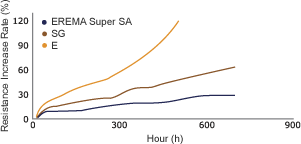

Standard EREMA heating elements are made from re-crystallized silicon carbide and are used in a wide variety of applications. For furnaces with a special atmosphere or where a volatile chemical may be generated during the heating process care must be taken with the element design and application. Aggressive and corrosive atmospheres may cause damage to the SiC structure, rapid oxidization, increased resistance and a subsequent decrease in element life – this process is called ageing.
To reduce this affect EREMA offer a range of protective coatings. These coatings, which are application specific, create a protective surface film that helps protect the SiC structure from chemical attack. As an extension and refinement of this technology, and to further improve element performance, TKK have now developed the EREMA SE type for rigorous environments.

Recently developed, using technology unique to TKK, the SE type differs significantly from conventional SiC heating elements. During manufacture, using material similar to the coating applied to standard EREMA elements, the SE type is infused to form a protect deposit throughout the SiC structure (ref. sketch) – not just on the surface. This protective deposit in depth affords the SE type greater durability when used in aggressive atmospheres or where corrosive gases may be present.
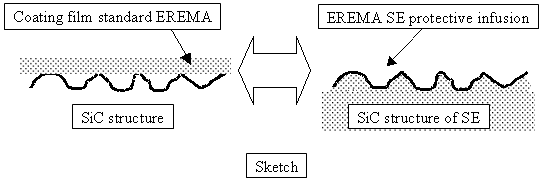

• Heat treatment of molten glass
• Heat processing atmosphere including water vapor

Available dimension for manufacture:
• Up to 2000mm in total length (Other dimensions quoted separately on request)

(Furnace temperature:1400°C, DP::+15 to +30)
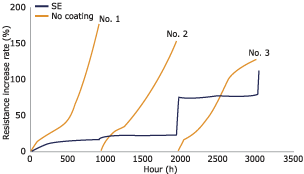
* The continuous test was conducted to investigate the deterioration of the SE type. (3048 hour running test including three shutdowns)
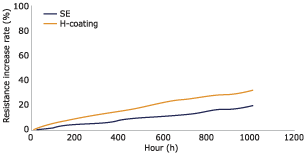
Ni 90%+H10%+water vapor atmosphere
(Furnace temperature:1350°C, DP:+20°C)

* The continuous test was conducted to investigate the deterioration of the SE type. (3067 hour running test including four shutdowns)

Standard EREMA heating elements are manufactured using re-crystallized silicon carbide and suit a variety of applications, however they are limited in their ability to withstand chemical attack at elevated temperatures. (For instance at temperatures over 1300 degrees Celsius, with a low dew- point atmosphere, standard SiC element service life will be shortened by an extreme reaction with nitrogen) To overcome these issues, employing unique technology, TKK has developed a high density, high strength and very durable heating element – the EREMA Super SA.
Radically different in material structure compared with conventional SiC heating elements the EREMA Super SA elements demonstrate many advantages most notably longer service life, resultant cost savings and the ability to operate at higher temperatures.
Furnaces using EREMA Super SA elements have reduced maintenance costs with less down-time production losses due to element failure. With the need to purchase fewer replacement elements and resultant increased productivity and furnace flexibility the EREMA SA is the obvious choice for aggressive atmospheres. This unique highly functional element is able to be used in applications up to 1600 degrees Celsius where conventional bar type SiC elements cannot.
Environmentally friendly, the longer life of these elements saves resources and reduces industrial waste due to premature element failure and loss of product.

Used in special atmospheres where SiC is detrimentally affected: Alkali, N2, H2, H2O, or halogen atmospheres .
High temperature element : Max. temperature 1600. Examples of usage: Fluorescent lamp coating, BME furnace, etc.

Outer diameter: Ø16 to Ø40
Heat generation length: max. 1000mm
In addition to straight bar form EREMA Super SA elements can be supplied in U and LU form. For dimensions outside our stated parameters please contact us.

| Characteristics | EREMA Super SA | E-F | SG-SGR |
|---|---|---|---|
| Apparent porosity | 10% | 23% | 5% |
| Apparent specific gravity | 3.17 | 3.2 | 3.1 |
| Bulk density | 2.85 | 2.5 | 2.8 |
| Resistivity | 0.045 Ω cm | 0.08/0.10 Ω cm | 0.016 Ω cm |
| Bending strength | 100MPa | 49MPa | 98MPa |
The resistivity value lies between our standard E, F types (re-crystallized structure) and SG, SGR types(reactive sintered structure). Bulk density and bending strength are comparable with SG, SGR types.

Fig. 1 shows the R-T characteristics indicating the nearly flat, positive characteristics.Fig. 1 shows the R-T characteristics indicating the nearly flat, positive characteristics.
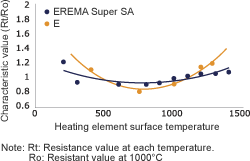

(1) Ni (93%) + H (7%) atmosphere
(Furnace temperature 1400°C, DP +30 to +40&Deg;C)
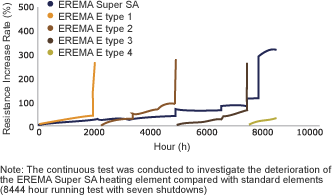

(2) Water vapor atmosphere
( Furnace temperature 1400°C, DP +80°C and over).
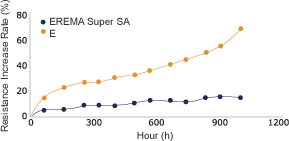

(3) Air atmosphere (Furnace temperature 1600°C)
